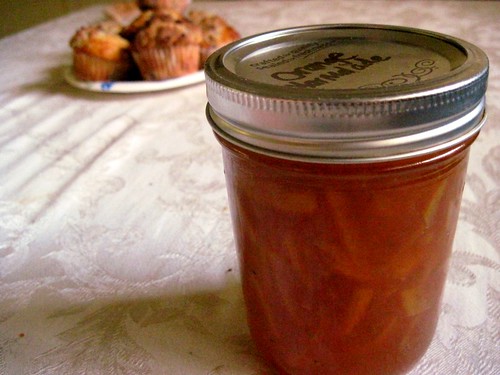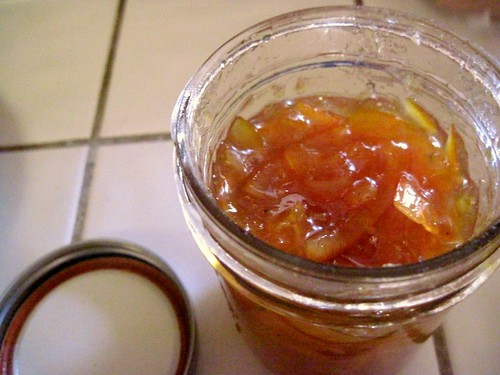So, obviously, by "soon" I meant I'd get this post up in a month. I'm sorry I've been so sparse lately. I have been cooking (quite a lot; let me tell you sometime about the cupcake-birthday-cake that I shaped and frosted like the Settlers of Catan game board-- or the Portal-themed cake (yes, it was a lie)-- or the war won ton soup that actually tasted like war won ton soup) but my camera's an angsty little old thing and so I don't have anything pretty to post up for you.
This I made back in Christmastime, though, for Mum, who is a huge orange marmalade fan. As a child, I never liked it, but after this I think I've been converted to its golden, sticky, bittersweet ways.
Marmalade comes from Greek quince jam (which was subsequently adopted by the Romans), called "marmelo." This means honey-fruit, as the quince was too bitter to be made into jam without honey.
In other countries, marmalade can refer to any fruit preserves, but in the majority of English-speaking cultures it refers primarily to citrus-based jams.
This recipe is adapted from Alton Brown's (yes, I am a Good Eats junkie. I accept this about myself). I swapped out some of the water for orange juice, and added cinnamon, salt, and a little pepper. Trust me, the pepper works.
Orange Marmalade
Adapted from AB's recipe: http://www.foodnetwork.com/recipes/alton-brown/orange-marmalade-recipe/index.html
4-5 large oranges
zest and juice of one lemon
2 C orange juice
4 C water
3 pounds plus 12 oz sugar
1 tsp cinnamon
1/2 tsp salt
a few grates of black pepper
canning jars (found in most grocery stores)
candy thermometer
Slice oranges into very thin disks. If you have a mandolin, that will be useful, but otherwise you can make due with a sharp knife. The slices should ideally be about 1/8th of an inch thick, but don't stress too much about it. Just try to make the slices all about the same size. Quarter those slices.
Put into a large pot with the lemon zest and juice, orange juice, and water. Boil for 10 minutes, then reduce heat to a simmer and let cook for 40 minutes. The fruit should be soft.
Meanwhile, fill a separate pot with water and the canning jars and lids. Bring to a rolling bowl for 10 minutes, then turn off the heat and let sit until the marmalade is done. This is to sterilize the jars.
Put a plate in the freezer. You'll need this later to check the marmalade.
Return the oranges to a boil. Add the sugar, cinnamon, salt and pepper and cook until the mixtures reaches 222 or 223 degrees. This should take 10-15 minutes. The way you test the marmalade's doneness is to put a teaspoon on the chilled plate and let sit for half a minute. Tilt the plate. If the marmalade runs, keep cooking. If it wobbles like a gel, you're done. (Imagine what you want your tasty, spreadable marmalade to look like; that's about the consistency it should come to on the chilled plate). Take it off the heat.
Place a towel out on the counter. Using a pair of tongs, remove your jars from the hot water and set them out, upright, on the towel. Ladle in marmalade until there's about half an inch of air gap left between the jam and the top of the jar. Use the tongs to put on the lids and then screw them gently tight.

Return the filled jars to the water. Bring the water to a boil again. Boil each jar 10 minutes. This will seal them. Remove from water and let sit until cool. If any of the lids are not flat and taut, then that jar didn't steal. Don't worry, just stick it in the fridge and eat it immediately. The other jars will stay good on the shelf for a few months. Once open, they must be refrigerated as well.
The marmalade is sweet and candy-like with a bitter edge. I'm a big fan. I hope you will be, too.


